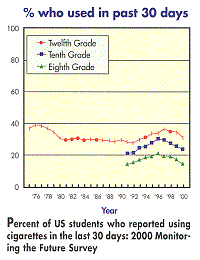Student Cigarette Smoking Falls Significantly
WASHINGTON-What a difference a year makes. Cigarette smoking dropped significantly among middle school and high school students between 1999 and 2000, according to a new federally funded report. For example, the percentage of high school seniors who had smoked at least once in the month prior to being surveyed fell from 34.6% to 31.4% (Figure). Those 12th graders who smoked a half pack of cigarettes or more each day declined from 13.2% to 11.3%.
WASHINGTONWhat a difference a year makes. Cigarette smoking dropped significantly among middle school and high school students between 1999 and 2000, according to a new federally funded report. For example, the percentage of high school seniors who had smoked at least once in the month prior to being surveyed fell from 34.6% to 31.4% (Figure). Those 12th graders who smoked a half pack of cigarettes or more each day declined from 13.2% to 11.3%.

The 2000 "Monitoring the Future Survey" queried more than 45,000 students in grades 8, 10, and 12 about their daily, past-month, past-year, and lifetime (at least once) usage of illicit drugs, alcohol, and tobacco products.
The University of Michigan’s Institute for Social Research conducts the annual survey for the National Institute on Drug Abuse (NIDA).
Alcohol and illicit drug use remained generally unchanged from 1999, although the survey revealed significant increases in use of ecstasy (MDMA) among all three grades and a significant decrease in cocaine use by high school seniors. Cigarette smoking, however, dropped across all categories in all grades surveyed, and most of the declines were significant.
"The study shows that efforts to change student attitudes on tobacco are having a positive impact," said President Clinton, who once again urged Congress to enact legislation giving the FDA broad authority to regulate the manufacture, marketing, and sales of tobacco products.
A number of encouraging findings emerged from the latest survey, which indicate that tobacco prevention programs are affecting student smoking.
The percentage of high school seniors who reported ever smoking a cigarette declined from 64.6% to 62.5%. Among 10th and 8th graders, the percentages dropped from 57.6% to 55.1% and from 44.1% to 40.5%, respectively.
Daily use of cigarettes dropped from 23.1% to 20.6% among seniors. Declines were seen in the other groups as well, from 15.9% to 14.0% for 10th graders and from 8.1% to 7.4%, for 8th graders, although the 8th grade finding was not statistically significant.
Among 10th graders, those who smoked a half-pack or more daily dropped from 7.6% to 6.2%; the decline among 8th graders was from 3.3% to 2.8%, but this drop was not significant.
Overall rates of smokeless tobacco use remained generally flat from 1999 to 2000. However, past-month usage among 12th graders dropped from 8.4% to 7.6%, which continued the decline of snuff and chewing tobacco from their peak usage of 12.2% recorded in 1995.